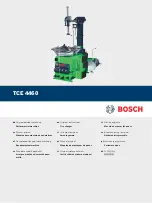
22
solutions creator
TC 522 - TC 528
ITALIANO
ENGLISH
ISTRUZIONI PER L’USO
OPERAZIONI PRELIMINARI
• Sgonfi are completamente il pneumatico.
• Togliere i pesi di equilibratura della ruota per eliminare
qualsiasi rischio derivante dalla presenza dei pesi stessi.
STALLONAMENTO (Fig.33)
• Mettere la ruota a terra, vicino allo stallonatore; avvici-
nare la paletta(E) al tallone e premere il pedale comando
stallonatore (B). L’operazione va eseguita in vari punti della
ruota fi nchè il tallone non sia completamente staccato.
• Ripetere l’operazione sul lato opposto della ruota.
INSTRUCTIONS FOR USE
PRELIMINARY OPERATIONS
• Completely defl ate the tyre.
• Remove wheel balancing weights to eliminate any danger
arising from their presence.
BEAD-BREAKING (fi g. 33)
• Place the wheel on the ground near the bead-breaker.
Move the plate(E) towards the bead and press the bead-
breaking control pedal (B).Th is operation is conducted at
various points of the wheel until the bead is completely
detached.
• Repeat the operation on the opposite side of the wheel.
DURANTE L’AZIONAMENTO DEL BRACCIO
STALLONATORE, PRESTARE ATTENZIONE
A NON COMPRIMERE GLI ARTI FRA LA
GOMMA E LO STALLONATORE STESSO !
SMONTAGGIO (fi g.34)
• Girare in senso antiorario la manopola di bloccaggio (L)
per sbloccare il braccio.
• Premere il pedale (D) per alzare il palo.
• Premere il pedale apertura (C) per predisporre le griff e
(O) per il bloccaggio esterno del cerchio (in caso di bloc-
caggio interno questa operazione non va eseguita).
• Mettere la ruota sull’autocentrante esercitando una lieve
pressione sul cerchio; premere (e rilasciare subito) il pedale
chiusura (C) per bloccarla.
• Lubrifi care il tallone con grasso utilizzando l’apposito
pennello in dotazione (ved. scatola degli accessori)
• Premere (e rilasciare subito) il pedale (D) per abbassare
il palo;
• Portare la torretta (I) vicino al cerchio e far toccare il rulli-
no (N) e la superfi cie al bordo; girando la manopola (L) in
senso orario si ottiene il distanziamento orizzontale e ver-
ticale automatico dal cerchio ed il bloccaggio del braccio.
• Con l’apposita leva alzare il tallone (fi g.35) ed appoggiarlo
sulla linguetta della torretta (I);
• Far ruotare l’autocentrante premendo il pedale (A) fi no
alla completa uscita del tallone dal cerchio.
• Alzare il palo premendo sul pedale (D) ed estrarre la ca-
Operare con cautela, evitando di inserire le dita
tra gomma e cerchione durante le fasi di rota-
zione dell’autocentrante.
mera d’aria.
• Ripetere le medesime operazioni per la fuoriuscita del
secondo tallone.
• In casi estremi con gomme molto larghe, è consigliabile
adoperare il Tecnohelp per l’estrazione del secondo tallone
(vedi istruzioni Tecnohelp).
WHEN USING THE BEAD-BREAKING ARM
TAKE CARE NOT TOTRAP LIMBS BETWE-
EN THE TYRE AND THE BEAD-BREAKER!
DEMOUNTING (fi g.34)
• Turn the locking grip (L) anti-clockwise to unlock the
arm.
• Press pedal (D) to raise the column.»Press the “open” pe-
dal (C) to prepare the jaws (O) for the external locking of
the rim (for internal locking this operation is not carried
out).
• Put the wheel on the chuck pressing down lightly on the
rim; press (andimmediately release) pedal (C) to lock it.
• Lubricate the bead with lubricant using the brush sup-
plied (see accesso-ries box).
• Press (and immediately release) pedal (D) to lower the
column;
• Move the head (I) near to the rim so that the roller (N)
touches the surface of the fl ange. Move the locking grip (L)
clockwise to achieve the automatic horizontal and vertical
distancing from the rim, as well as locking the arm.
• Raise the bead with the special lever (fi g. 35) and place it
on the head tongue (I).
• Rotate the chuck by pressing the pedal (A) until the bead
comes completely out of the rim.
Take care not to insert fi ngers between tyre and
rim while thechuck is rotating.
• Raise the column by pressing pedal (D) and remove the
inner tube.
• Repeat the operation to remove the second bead.
• In extreme cases with very large tyres, it is advisable to
use the Tecnohelp for extracting the second bead (see Tec-
nohelp instructions).
fi g.34
3
L
H
I
N
4
O
P
Q
1
D
C
B
A
2
F
E
G
fi g.35
fi g.33
- TC 525




































